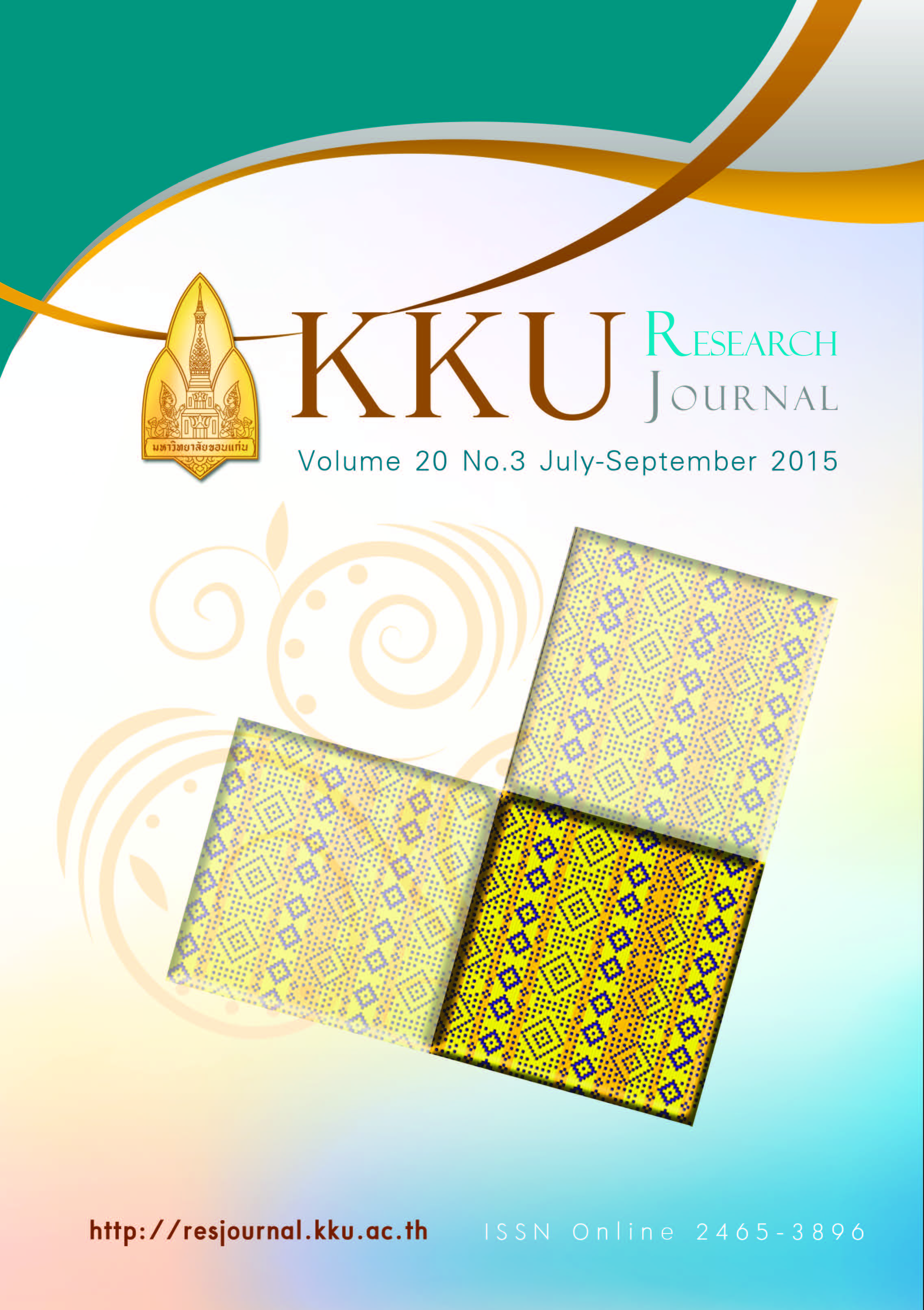Calculation of structural and optical properties of silicon quantum dots: tuneable absorption energy and negative electron affinity
Main Article Content
Abstract
The structural and optical properties of hydrogen-terminated silicon quantum dots were investigated by using the Gaussian 09 program. The models of silicon quantum dots assume that the silicon atoms are covalently bonded in diamond crystal structure, with quantum dot diameters varying from 0.8 to 1.6 nanometers. The bonds of silicon atoms at the surface were terminated by hydrogen atoms. The calculations of optimized structures and ground state electronic properties for the quantum dots have been performed using Hartree-Fock with 6-31G* basis set, and the exited states were then calculated by using time-dependent density functional theory (TDDFT) with (B3LYP) hybrid functional. The results show that the hydrogen-terminated silicon quantum dots have tuneable absorption energy, depending on particle size, and the larger particles have lower absorption energy. The calculated UV-VIS spectrum results show that with the quantum dots diameter changing from 0.8 nm to 1 nm to 1.2 nm the absorption peak moves from 5.23 eV (238 nm) to 4.68 eV (264 nm) to 4.03 eV (308 nm). Moreover, the hydrogen-capped silicon nanocrystals also show negative electron affinity (NEA).
Article Details
References
[2] Jianwei Liu, Folarin Erogbogbo, Ken-Tye Yong, Ling Ye, Jing Liu, Rui Hu, Hongyan Chen, Yazhuo Hu, Yi Yang, Jinghui Yang, Indrajit Roy, Nicholas A. Karker, Mark T. Swihart, and Paras N. Prasad, “Assessing Clinical Prospects of Silicon Quantum Dots: Studies in Mice and Monkeys”, Acs. Nano, 8, 7303 (2013).
[3] F. Maier-Flaig, J. Rinck, M. Stephan, T. Bocksrocker, M. Bruns, C. Kubel, A. K. Powell, G. A. Ozin, and U. Lemmer, “Multicolor Silicon Light-Emitting Diodes (SiLEDs)”, Nano Lett, 13, 475 (2013).
[4] Qi Wang, Yongping Bao, Xiaohong Zhang, Paul R. Coxon, Upali A. Jayasooriya, and Yimin Chao, “Uptake and Toxicity Studies of Poly-Acrylic Acid Functionalized Silicon Nanoparticles in Cultured Mammalian Cells”, Adv. Healthcare Mater., 1, 189 (2012).
[5] Daniel P. Puzzo, Eric J. Henderson, Michael G. Helander, ZhiBin Wang, Geoffrey A. Ozin, and Zhenghong Lu, “Visible Colloidal Nanocrystal Silicon Light-Emitting Diode”, Nano Lett., 11, 1585 (2011).
[6] Melanie L. Mastronardi, Frank Hennrich, Eric J. Henderson, Florian MaierFlaig, Carolin Blum, Judith Reichenbach, Uli Lemmer, Christian Kubel, Di Wang, Manfred M. Kappes, and Geoffrey A. Ozin, “Preparation of Monodisperse Silicon Nanocrystals Using Density Gradient Ultracentrifugation”, Journal of the American chemical society, 113,11928 (2011).
[7] Melanie L. Mastronardi, Florian Maier-Flaig, Daniel Faulkner, Eric J. Henderson, Christian Kübel, Uli Lemmer, and Geoffrey A. Ozin. “Size-Dependent Absolute Quantum Yields for Size-Separated Colloidally Stable Silicon Nanocrystals”, Nano Lett., 12, 337 (2012).
[8] Kai-Yuan Cheng, Rebecca Anthony, Uwe R. Kortshagen, and Russell J. Holmes, “Hybrid Silicon Nanocrys-tal-Organic Light-Emitting Devices for Infrared Electroluminescence”, Nano Lett. 10, 1154 (2010).
[9] Kai-Yuan Cheng, Rebecca Anthony, Uwe R. Kortshagen, and Russell J. Holmes, “High-Efficiency Silicon Nanocrystal Light-Emitting Devices”, Nano Lett., 11, 1952 (2011).
[10] Katerina Dohnalova, Alexander N Poddubny, Alexei A Prokofiev, Wieteke DAM de Boer, Chinnaswamy P Umesh, Jos MJ Paulusse, Han Zuilhof and Tom Gregorkiewicz, “Surface brightens up Si quantum dots: direct bandgap-like size-tunable emission”, Light: Science & Applications, 2, e47 (2013).
[11] David Jurbergs and Elena Rogojina, “Silicon nanocrystals with ensemble quantum yields exceeding 60%”, Appl. Phys. Lett. 88, 233116 (2006).
[12] Gaussian 09, Revision A.1, M. J. Frisch, G. W. Trucks, H. B. Schlegel, G. E. Scuseria, M. A. Robb, J. R. Cheeseman, G. Scalmani, V. Barone, B. Mennucci, G. A. Petersson, H. Nakatsuji, M. Caricato, X. Li, H. P. Hratchian, A. F. Izmaylov, J. Bloino, G. Zheng, J. L. Sonnenberg, M. Hada, M. Ehara, K. Toyota, R. Fukuda, J. Hasegawa, M. Ishida, T. Nakajima, Y. Honda, O. Kitao, H. Nakai, T. Vreven, J. A. Montgomery, Jr., J. E. Peralta, F. Ogliaro, M. Bearpark, J. J. Heyd, E. Brothers, K. N. Kudin, V. N. Staroverov, R. Kobayashi, J. Normand, K. Raghavachari, A. Rendell, J. C. Burant, S. S. Iyengar, J. Tomasi, M. Cossi, N. Rega, J. M. Millam, M. Klene, J. E. Knox, J. B. Cross, V. Bakken, C. Adamo, J. Jaramillo, R. Gomperts, R. E. Stratmann, O. Yazyev, A. J. Austin, R. Cammi, C. Pomelli, J. W. Ochterski, R. L. Martin, K. Morokuma, V. G. Zakrzewski, G. A. Voth, P. Salvador, J. J. Dannenberg, S. Dapprich, A. D. Daniels, Ö. Farkas, J. B. Foresman, J. V. Ortiz, J. Cioslowski, and D. J. Fox, Gaussian, Inc., Wallingford CT, 2009.
[13] A. Szabo, and Neil S. Ostlund, “Modern Quantum Chemistry: Introduction to advanced electronic structure properties”, Dover Publications, New York, 1996.


